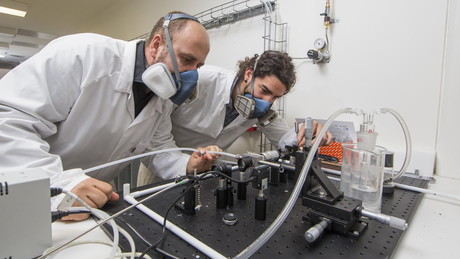ANU sensors make wearable medical diagnostic devices possible

Scientists from The Australian National University (ANU) have designed tiny optical sensors that open the door to developing a wearable device that allows doctors to medically diagnose people’s health in real time.
Associate Professor Antonio Tricoli said the sensors, which are 50 times thinner than a human hair, promised to one day help doctors detect diseases such as diabetes much earlier than is possible today, and better manage a range of chronic diseases.
“These ultrasmall sensors could be integrated into a watch to literally provide a window on our health,” said Dr Tricoli, leader of the Nanotechnology Research Laboratory at the ANU Research School of Engineering. “This exciting invention shows that we are on the cusp of designing the next generation of wearable devices that will help people to stay well for longer and lead better lives.”
Tricoli said the sensors could measure very small concentrations of gases coming through the skin and breath called metabolites, allowing doctors to keep track of people’s health in real time.
“You could simply use a pulse of light to track these biomarkers of disease — there’d be no need for batteries, wires or large and expensive lab equipment,” he said. “A wearable medical diagnostic device using our optical sensors may one day eliminate the need for blood tests and many other invasive procedures.”
Zelio Fusco, a PhD scholar in Dr Tricoli’s lab, said the new sensors had advantages over other types being developed for wearable medical devices because they could detect metabolites in much smaller concentrations and operate at room temperature.
“The beauty of our sensors is that they are super versatile and can be integrated into different technologies for applications ranging from medical diagnosis, farming and space exploration,” said Fusco. “Our sensors could be developed to detect whether a plant has a particular disease or a fruit is ripe, for example.”
Co-researcher Dr Mohsen Rahmani said the sensors combined very small gold nanostructures with semiconductors in a way that created unique properties to enable the detection of gas molecules at very low concentrations.
“As the sensors are ultrasmall and ultralight, they could potentially be fitted to microsatellites or tiny spacecraft that could help in the hunt for life on distant planets, by telling us if there are trace organic molecules of living organisms on distant planets,” said Dr Rahmani, an Australian Research Council (ARC) Discovery Early Career Research Fellow at the ANU Research School of Physics and Engineering.
The ANU research was supported by Queensland University of Technology and the Chalmers University of Technology in Sweden. The research is published in Advanced Materials1.
Reference:
- Fusco Z, Rahmani M et al 2018, Nanostructured Dielectric Fractals on Resonant Plasmonic Metasurfaces for Selective and Sensitive Optical Sensing of Volatile Compounds, Advanced Materials, June 2018.
Omron and Cognizant partner on IT–OT integration
Omron Corporation and Cognizant have announced they have signed a strategic partnership to...
Greensteel Australia to build next-generation steel mill
Greensteel Australia has announced it has placed an order to purchase equipment for its...
Researchers design water filter that removes PFAS molecules
Researchers at Monash University have developed a water filtration membrane that effectively...








